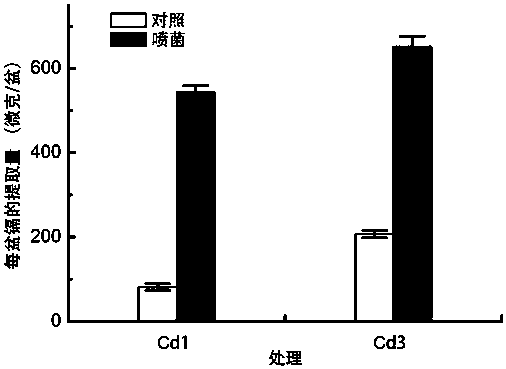Manufacturing method for plant heavy metal enrichment accelerant based on pseudomonas syringae
A technology of Pseudomonas and heavy metals, applied in the biological field, can solve the problems of low biomass, slow growth, low dry matter accumulation, etc.
- Summary
- Abstract
- Description
- Claims
- Application Information
AI Technical Summary
Problems solved by technology
Method used
Image
Examples
Embodiment 1
[0036] Example 1, preparation of a heavy metal enrichment accelerator based on Pseudomonas syringae: (1) Preparation of Pseudomonas syringae, Pst The medium of DC3000 strain is all low-salt LB medium (recipe: each liter of medium contains: peptone 10g; yeast extract powder 5g; sodium chloride 5g). The DC3000 strain stored at -80 °C was taken out of the ultra-low temperature refrigerator, streaked onto the low-salt LB solid medium containing an appropriate amount of antibiotics, and cultured at 28 °C for 36-48 h. A single colony was picked, inoculated into a 10 ml seed tube, and cultured on a constant temperature shaker at 28 °C and 120 rpm for about 10 h. The fresh culture was inoculated into low-salt LB liquid medium containing appropriate amount of antibiotics according to the ratio of 1:100, and continued to grow overnight on a constant temperature shaker at 28 °C and 120 rpm until OD600≈0.8. Transfer the final product to a centrifuge tube, centrifuge at 1500 g for 20 mi...
Embodiment 2
[0037] Example 2, soil for testing: collected from uncontaminated wheat field surface soil (0-20cm) in the suburbs of Qingyang City, Gansu Province: the organic matter content is 10.58 g·kg −1 , total nitrogen 0.82 g·kg −1 , Alkaline hydrolyzed nitrogen 52.45 mg·kg −1 , total phosphorus 0.659g·kg −1 , available phosphorus 11.24 mg·kg −1 , available potassium 152.88 mg·kg −1 , total cadmium: 0.039 mg.kg -1 . With reference to my country's "Soil Environmental Quality Standards, 1995", two cadmium levels were set up in this embodiment, Cdl (1 mg / kg soil) and Cd3 (3 mg / kg soil), to simulate light and moderate cadmium pollution in farmland soil respectively. And by artificially adding 3CdSO 4 .8H 2 O solution is realized. 20 kg of well-mixed soil at each cadmium level was packed into plastic turnover boxes respectively, and the size of the turnover box was 42 cm (length) X 32 cm (width) X 16 cm (height). In order to stabilize various adsorption balance characteristics of th...
Embodiment 3
[0040] Embodiment 3, test soil is the same as embodiment 2.
[0041] Test plant: Tobacco (variety name: Yunyan-87), tobacco seeds were sprayed with 3% H before sowing 2 o 2 Soak for 10 minutes, then rinse 3 times with tap water, and grow seedlings in the greenhouse. After 1 month, transplant the seedlings into the turnover box (8 plants / box), water every day to keep the soil moisture suitable, and there is no soil moisture during the whole test period. Add any fertilizer. Randomly grouped, 1 week before the harvest, spray water (as a control) or the plant heavy metal enrichment accelerator (spray) prepared in Example 1 respectively on the leaf surface, and then cover the agricultural film to keep the relative humidity of the environment RH≥ 80% until harvest.
[0042] The plants were transplanted to the turnover box and harvested after 2 months. The residual amount of cadmium in soil was determined by flame atomic absorption spectrometry [flame atomic absorption spectrosco...
PUM
 Login to View More
Login to View More Abstract
Description
Claims
Application Information
 Login to View More
Login to View More - R&D
- Intellectual Property
- Life Sciences
- Materials
- Tech Scout
- Unparalleled Data Quality
- Higher Quality Content
- 60% Fewer Hallucinations
Browse by: Latest US Patents, China's latest patents, Technical Efficacy Thesaurus, Application Domain, Technology Topic, Popular Technical Reports.
© 2025 PatSnap. All rights reserved.Legal|Privacy policy|Modern Slavery Act Transparency Statement|Sitemap|About US| Contact US: help@patsnap.com



